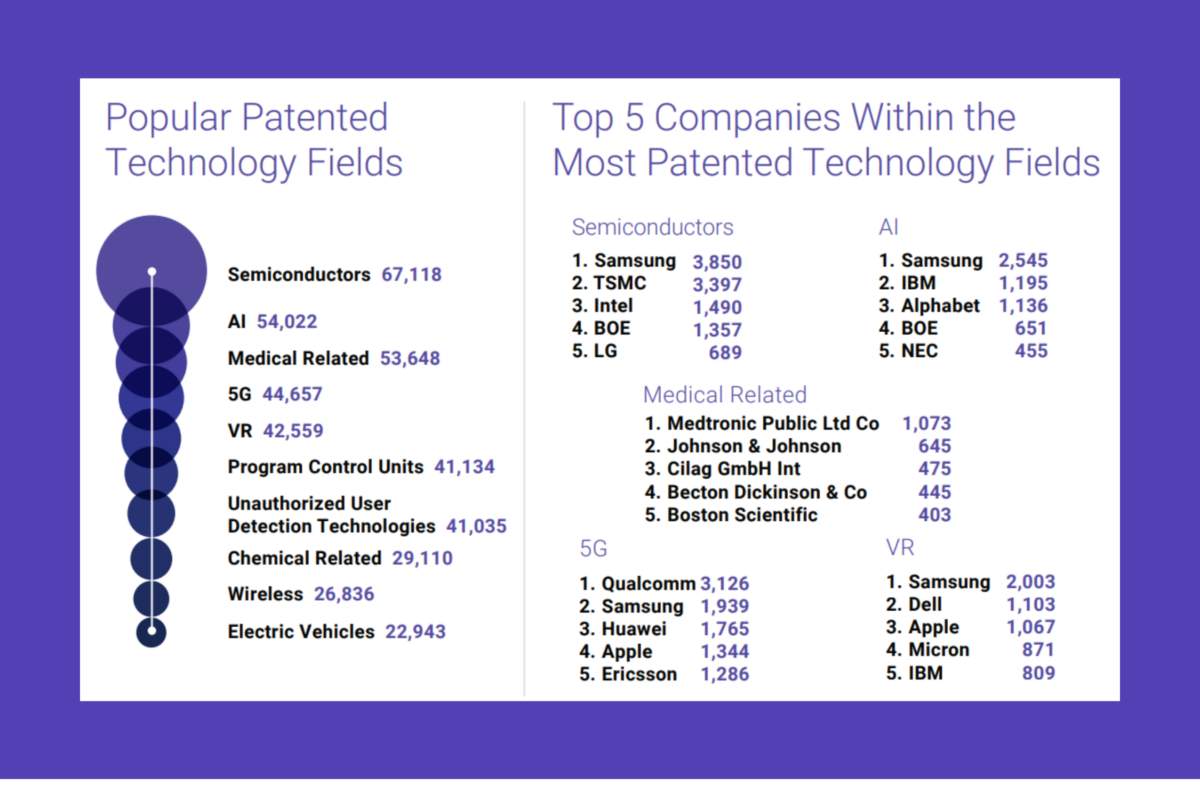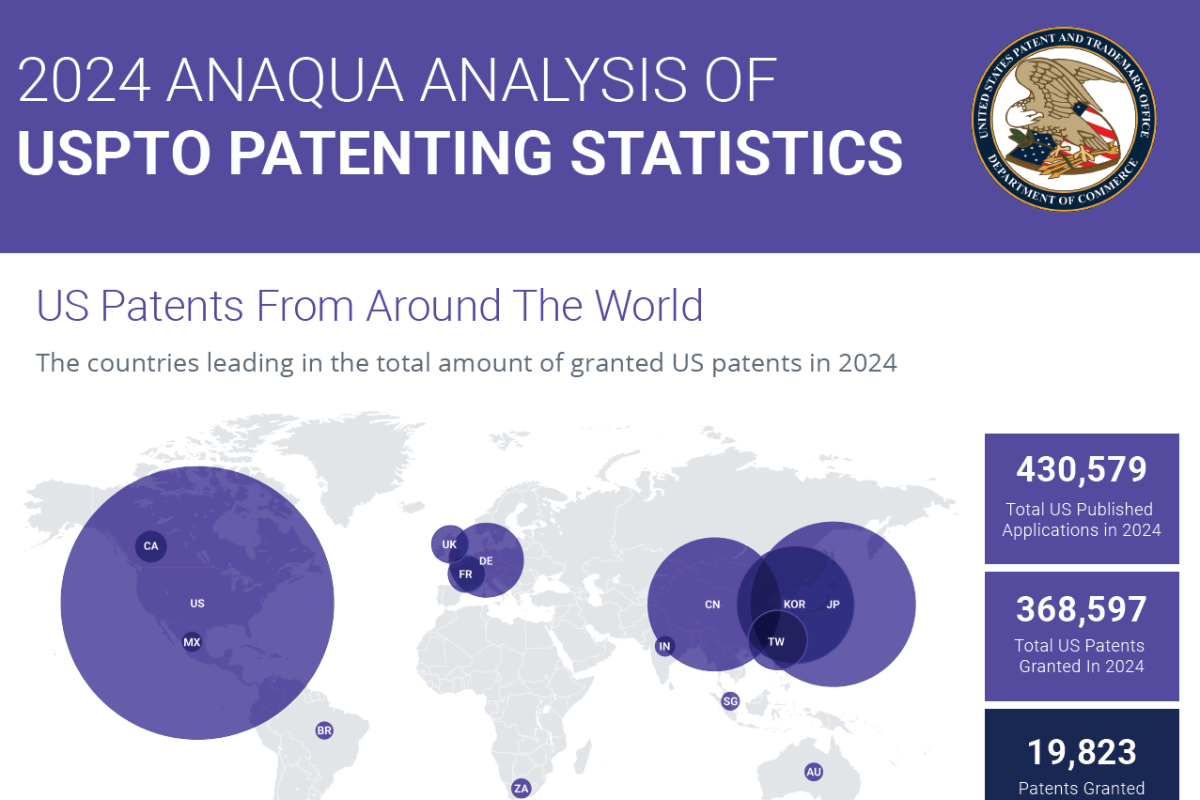By Shayne Phillips, Director, Analytics Solutions at Anaqua
Green investments continue to be a top priority for many businesses, with 57% of C-suite leaders increasing their investment in sustainable solutions and green technology according to a recent survey. From renewable energy solutions to eco-friendly innovations, the diverse realms of green technology and the intellectual property (IP) behind them play a critical role in shaping a sustainable future.
Using data from Anaqua’s patent search and analytics tool, AcclaimIP, this article provides an analysis of global companies patenting environmentally friendly technologies, highlighting the ongoing commitment to preserving and nurturing our planet.
This article examines exactly what technologies all companies, big and small, are investing in as we all look for ways to continue moving toward a more sustainable future. It is based on organisations filing and granting go-green related matters in the United States, utilising established Cooperative Patent Classification (CPC) taxonomy terms for Climate Change-Related Technologies: Y02 and Y04S.
The list of the top 10 leading organisations innovating in green technology areas – in terms of volume of patents – showed significant movement between 2023 and 2022.
Toyota, General Electric and Samsung Electronics remain in first, second and third (respectively) between 2022 and 2023, while some other players moved around.
Panasonic and Ford flip-flopped between fourth and fifth place, while General Motors and Raytheon similarly switched between the sixth and seventh-place rankings.
Rounding out the shifts in the 2023 list are Samsung SDI and Hyundai, which switched between the eighth and tenth place.
Automotive Industry Leads the Pack
Players from the automotive industry continue to have a strong presence in green technology, with Toyota, Ford, General Motors and Hyundai all making the top 10 green-based IP list. Additionally, Honda once again finds itself in the top 10 list for 2023, rejoining its automotive peers after a short hiatus in 2022.
With Honda re-entering the list and automotive companies making up half of the top 10, let’s dive deeper into the specific technologies where these green-ranking automotive companies are patenting.
The top 12 technology areas outlined here are either related directly to green technology (ie, top-designated by Y02 or Y04S CPC codes), or indirectly related technology CPCs assigned as co-designations on their respective green-related patents (ie, codes assigned in tandem with Y02 and/or Y04S assignments).
Unsurprisingly, all five automotive companies have a strong presence in the T10 CPC Main Group related to green technologies around road travel of either goods or passengers. Toyota has double the patent contributions toward greenhouse gas (GHG) emission mitigation technologies (CPC E60) than its four rivals and triple the patent contributions related to secondary battery cell manufacturing technology (H01M10).
Interestingly, Hyundai beats out Toyota for the most patents in indirect GHG mitigation enabling technologies (Y02T90). Meanwhile, Ford has the highest number of matters related to electrical control of combustibles supply during vehicle operation (F02D41).
General Motors’ strongest showing relates to their patent filings around fuel cell manufacturing (H01M8), while Honda represents well in filings related to general electrical propulsion technology (B60L50).
Rounding out the top 12 patenting areas related to green technology are propulsion unit arrangements (B60K6); conjoint control of vehicle subunits (B60W10); hybrid vehicle control systems (B60W20); circuit arrangements for battery/fuel cell control/monitoring (B60L58); and electrical propulsion control system technologies (B60L2240).
This chart outlines the top 12 technology areas related to green technology in the automotive industry, as outlined by their CPC designations.
Non-auto deep dive
The remaining five companies that make up the top 10 list span across industries and include a broad range of technologies they aim to obtain patent rights toward.
Samsung Electronics has a presence in each of the displayed 17 technology areas, with well over 2,500 patents in the E10 CPC Main Group under the CPC designation related to energy generation via renewable energy sources (Y02E10).
Battery manufacturer Samsung SDI shows particular strength with filings in the distinct technical areas of final product-related climate change mitigation (Y02P70), GHG emissions mitigation (Y02E60), secondary battery cell manufacture (H01M10) and battery electrode technologies (H01M4).
General Electric is hot on the heels of both Samsung Electronics and Samsung SDI in the volume of patents, with their filings in the five technical areas represented by CPC designations Y02E10, Y02P70, Y02E60, H01M10 and H01M4.
Panasonic – much like Samsung Electronics, Samsung SDI and General Electric – has a filing presence in those same five CPC designated areas, as well as filings in these additional technical areas: communication network energy consumption reduction (Y02D30); green-related electrical digital data processing (G06F1); energy efficient computing (Y02D10); wireless communication network power management (H04W52); and green-related semiconductor technology (H01L27).
Raytheon, an aerospace and defence company, rounds out this group with a patent presence in the CPC-designated Y02E10, Y02E60 and H01M10 technology areas. Other technologies on the chart above not yet mentioned link to green-related filings around electric solid-state semiconductors (the H10K CPC subclasses) and filings around physics-based inventions in CPC Section G.
Small entities and universities patenting in green technologies
There are countless large companies not yet mentioned in this analysis, as well as universities and small organisations working hard to make the environment and the world better for future generations.
Small companies and universities worldwide are just as invested in green technology as large corporations and the investment community are. The chart in this section includes patentees filing at the US Patent and Trademark Office under the entity statuses of small or micro.
When comparing to 2022, Battelle Memorial Institute and Global Graphene appear again at the top of the small/micro patentees’ chart, moving up to occupy the second and third spots respectively in the ranking, behind Korea Electronics & Telecom Research Institute in the top spot.
Xyleco Inc. (fourth, a biomass processing technology company); the Alliance for Sustainable Energy (fifth, an LLC governed by Battelle and MRIGlobal); the Korea Institute of Energy Research (sixth); Strong Force IOT Portfolio 2016 (seventh, a bundled technology-specific IP portfolio from Strong Force Innovation Portfolios); Southwest Research Institute (eighth); and Gas Technology Institute (ninth) round out the rest of the small and micro entities patenting in green technologies.
Universities are also patenting go-green technologies. The University of California, which consistently ranks first year after year, appears in the top spot again in 2023. A full list of the top 10 universities filing for green-related patents in the US can be found in the chart below.
Securing our future by advancing innovation for a green planet, together
Reflecting on the ongoing theme of investing in our planet as we look toward the new year, it is evident that there is much reason for hope.
By examining recent technology patents and exploring established areas of green innovation, we witness the collective efforts of companies across various technology sectors to make a positive impact on the planet. Their commitment and dedication create a crucial balance, ensuring that the power to effect meaningful change lies within the grasp of each and every one of us.
As we move forward, let us continue to embrace and support these endeavors, fostering a sustainable future for generations to come.
Further Reading




